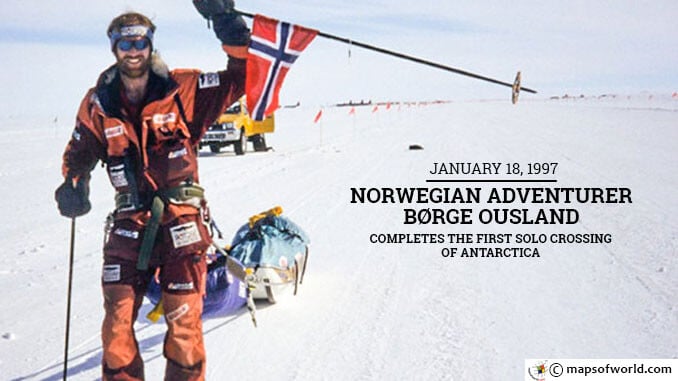On January 18, 1997, Norwegian adventurer and polar explorer Børge Ousland completed the first solo crossing of Antarctica battling his way through the extremely harsh terrain on foot and on skis for 64 days. The explorer was the very first to make this arduous journey alone – unaided by a team or by other companions. On November 15, 1996, Ousland set out with three other adventurers – each wanting to make it alone and set the record. While British explorer, Sir Ranulph Twistleton-Wykeham-Fiennes dropped out of the mission sometime in December, having been tormented by kidney stones, Polish explorer Marek Kaminsky, could not catch up with Ousland in terms of his speed and had abandoned his exploration at the South Pole base. The South Korean competitor, Heo Young Ho, set out with the rest but went missing in the course of the journey. Ousland’s showdown with Sir Fiennes was reminiscent of the race between Norwegian explorer Roald Amundsen and the Briton Robert Scott in 1911 when both set out to conquer the South Pole. In both cases the Norwegians won. Ousland and the other explorers agreed to undertake the 1,864-mile crossing which included hauling all their supplies on sledges, climbing the South Pole Plateau which measures approximately 9,800 feet, surviving temperatures well below 105ºF, and battling loneliness and harsh winds. The solo crossing was made tougher by the explorers who decided that they would go unaided by dog sledges and without having supplies dropped to them from air-transport vehicles. Ousland set off carrying 341 pounds of supplies and estimated that the crossing would take 90-100 days. His feat was well below all estimates. In his article “How I Crossed Antarctica Alone” published in The Guardian in December 2013, Ousland describes his amazing journey in great detail. Setting out from the north-eastern corner of Berkner Island, he went through Dufek Massif in the Pensacola Mountains of eastern Antarctica. The route that took him to the plateau at the South Pole stretched between the Washington Mountains and the Forrestal Range with Saratoga Table. This trial was picked out by Ousland based on aerial photographs of the region. Ousland decided not to stay in the cozy comfort of the South Pole but moved on using the wind to assist his ski trip towards the coast. On his way down, Ousland chose to take the trail along the Axel Heiberg glacier, which was 124 miles longer than the Baerdmore glacier but was also a safer one. Despite the extreme weather and hazardous nature, Ousland immensely enjoyed his journey. “To be in the middle of the strong Arctic or Antarctic nature with just your sled and skies, to be self-supplied for up to three months at the time, is a lifelong and intense experience”, Børge Ousland later said about the journey. He then had to cross the 310-mile stretch across the Ross Ice Shelf and the treacherous Minna Bluff to reach McMurdo Station, a US research unit, where he spent a few days. Ousland completed his journey by reaching Scott Base on January 17. With this, Ousland also became the first person to reach both poles alone and unaided. This was also the last of the great exploration records to be set in the world. Børge Ousland was born on May 31, 1962 and has long been a polar explorer, writer, and photographer. He is one of the very few of explorers who have successfully completed missions to both the North and South poles. Børge Ousland now puts in his immense experience into lectures, guiding expedition teams with planning trips, and assisting with films about the wilderness. Ousland has authored 9 books so far. He is represented by the National Geographic Speakers Bureau which forms a part of the National Geographic Society, Washington, D.C. “Børge Ousland is arguably the most accomplished polar explorer alive!” said National Geographic Adventure in February 2006. You may also like : January 18 1788 – The First Fleet Arrives in Botany Bay, Australia
January 18 1997 – Norwegian Adventurer Børge Ousland Completes The First Solo Crossing of Antarctica
On January 18, 1997, Norwegian adventurer and polar explorer Børge Ousland completed the first solo crossing of Antarctica battling his way through the extremely harsh terrain on foot and on…
725
